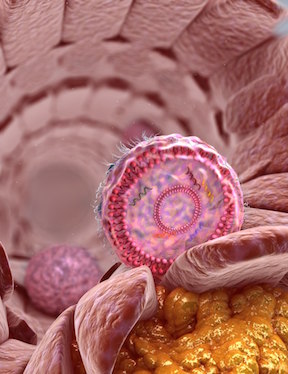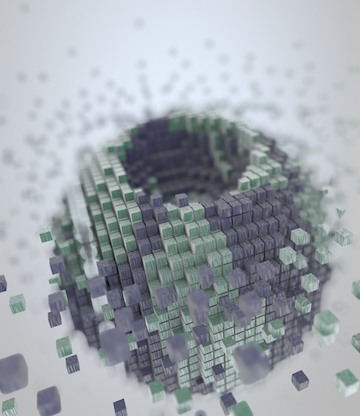The Path of a Scientific Illustrator: An Interview with Ella Marushchenko
News Article by Rachel Walker, PhD Graduate Student in the Department of Pharmacology and Physiology
 Imagine that after spending months developing a great story with your research, you really want your work to stand out. So you decide to include an illustration. This added dimension for the article could expand your audience and help give your work the recognition it deserves. But without knowing whom to ask, how do you obtain an illustration like this? Who can you approach? This is where a scientific illustrator such as Ella Marushchenko enters the picture.
Imagine that after spending months developing a great story with your research, you really want your work to stand out. So you decide to include an illustration. This added dimension for the article could expand your audience and help give your work the recognition it deserves. But without knowing whom to ask, how do you obtain an illustration like this? Who can you approach? This is where a scientific illustrator such as Ella Marushchenko enters the picture.
The symbiotic relationship between art and science is easy to understand – both emphasize the importance of observation. Realistic drawings of nature have been used to describe human anatomy and diseases, as well as communicate the diversity of life (think of Darwin’s observations, Leeuwenhoek’s and Hooke’s microscopic universe, or Vesalius’s human anatomy). More recently, depictions on the subcellular level have aided in better understanding of molecular structures. Art is also an important part of education, from illustrations of medical techniques to the schematics of complex biological phenomena in textbooks. Many of us likely first view a paper’s graphical abstract or pathway diagram to obtain a “snapshot” of the work before diving into the entire paper. This is especially helpful if the topic is not your area of expertise. Like any form of science communication, the purpose of graphics like these is to distill and symbolize work in a way that is striking, yet clear and comprehensible.
Which leads us back to Marushchenko, who has followed a fascinating and dedicated path to where she is now: owner and art director of Ella Maru Studios, Inc.
Born in Ufa, Russia, the artistic family first knew she would follow a similar path when they saw the young three-year old “drawing a girl with a square green head.” Fast forward to earning a Master’s degree in Art from Bashkir State Pedagogical University. After experiencing eight years training in the studio of the famous Russian painter Sergey Krasnov and his assistant Vera Asambaeva, Marushchenko then traveled to the Czech Republic to learn more about European art and study art restoration. Throughout this time, she gained experience in a variety of techniques including oil and acrylic painting, watercolor, and ceramics. She has also become proficient in multiple computer programs. Beyond her skills with the materials, she discovered the vital skill of how to “feel the art.”
 In 2012, Marushchenko moved to the U.S., where she planned to create pieces for home décor and found herself, instead, quickly immersed in the world of science illustration. This transition was encouraged by Dr. Sergiy Minko, with whom Marushchenko’s husband Alex Tokarev had accepted a postdoc position while at Clarkson University. Dr. Minko requested Marushchenko illustrate his articles. “Dr. Minko (now at the University of Georgia) had an article accepted in Advanced Functional Materials magazine and asked me to make a cover image for his article,” she said. “I was not prepared for that and did not see myself as a scientific illustrator, but Sergiy, and other scientists, really wanted to see the results. He would not take NO for an answer. I made my first scientific image and it was chosen as a cover.”
In 2012, Marushchenko moved to the U.S., where she planned to create pieces for home décor and found herself, instead, quickly immersed in the world of science illustration. This transition was encouraged by Dr. Sergiy Minko, with whom Marushchenko’s husband Alex Tokarev had accepted a postdoc position while at Clarkson University. Dr. Minko requested Marushchenko illustrate his articles. “Dr. Minko (now at the University of Georgia) had an article accepted in Advanced Functional Materials magazine and asked me to make a cover image for his article,” she said. “I was not prepared for that and did not see myself as a scientific illustrator, but Sergiy, and other scientists, really wanted to see the results. He would not take NO for an answer. I made my first scientific image and it was chosen as a cover.”
Today, Marushchenko is surrounded by science, with many close friends involved in various fields, as well as her husband who has a Ph.D. in Materials Science. As the company’s founder and consultant, he often supports her ideas and reviews her work. Much of the understanding about a project is through communication between Marushchenko and her client. Sometimes a client approaches her with a specific end product in mind, but just as often clients give her creative freedom concerning the image or animation. “It becomes a team effort,” she noted.
Marushchenko’s abilities with different artistic mediums are useful because they correlate so well to a wide range of projects. For example, botanical illustrations are typically hand drawn but molecular images are created on a computer program. She also uses different media to further understand a project. If a structure is confusing, she will sculpt a model with polymer clay before moving to the final illustration.
Marushchenko answered questions about a variety of topics related to her art, range of projects, and life in science.
What does an average day, or even week, look like for you? What is your work/life balance like?
“I wake up, check my e-mails, and respond to my e-mails from my clients. Then I usually post to my social media accounts. Next I get the biggest cup of coffee and work on current projects until 6 pm. From 6 pm to 8 pm I usually go to yoga or to the beach. Then back home and work until midnight. Saturday is my only day off and I try to not do any work this day.
What do you enjoy most about your work?
I am happy to be not only an artist but also a creator of something that explains how our body works. It makes me feel that I am doing something bigger than just illustrations. I feel like a small part of every research project that I help to illustrate.
What artistic aspects give you the most trouble?
Not many people know that in real life I am a huge hypochondriac. This is a difficult burden for someone who is a medical illustrator!
What skills are most important in what you do? Did you have these going in, or did you learn on the job?
I cannot say what skills are most important. I have to learn something new every day. You have to be really flexible because it is never just art. It is also science, marketing, sales and working with clients. All of these skills are important. You have to study every day. You cannot progress without learning something new. Of course, my degrees help me a lot but you cannot be ‘just an artist.’
What advice would you give to people thinking about working in scientific illustration?
Never think that it is an easy job. Never think you will have freedom to create only your vision of the research. Learn different art techniques, and most important - be prepared to work hard!
Contact Ella Marushchenko and view her portfolio at: http://www.scientific-illustrations.com/
Rachel Walker is a graduate student in the Department of Pharmacology and Physiology. She received dual degrees in Biochemistry and Art History at SUNY Geneseo, and continues to paint and illustrate whenever possible.
Tracey Baas |
10/7/2016
You may also like